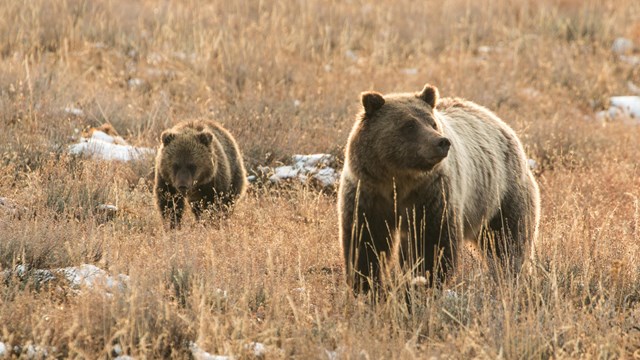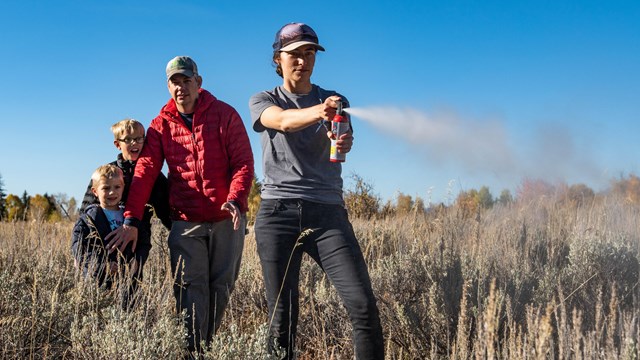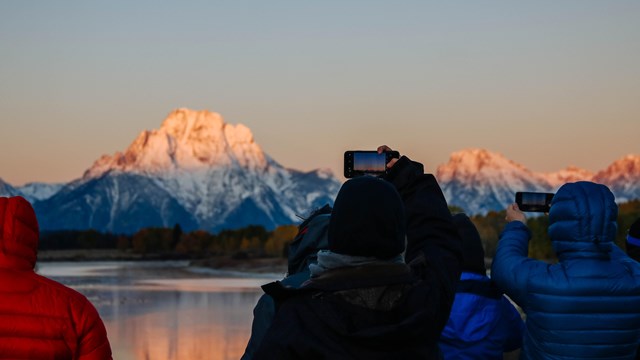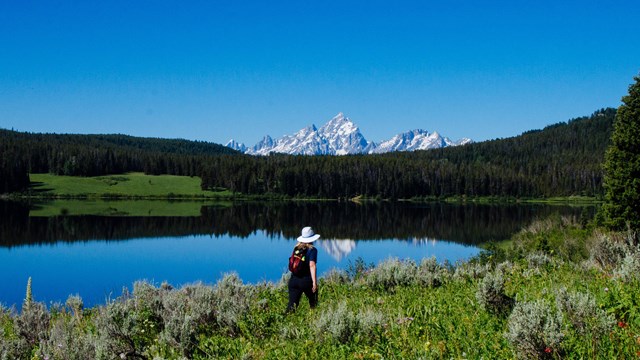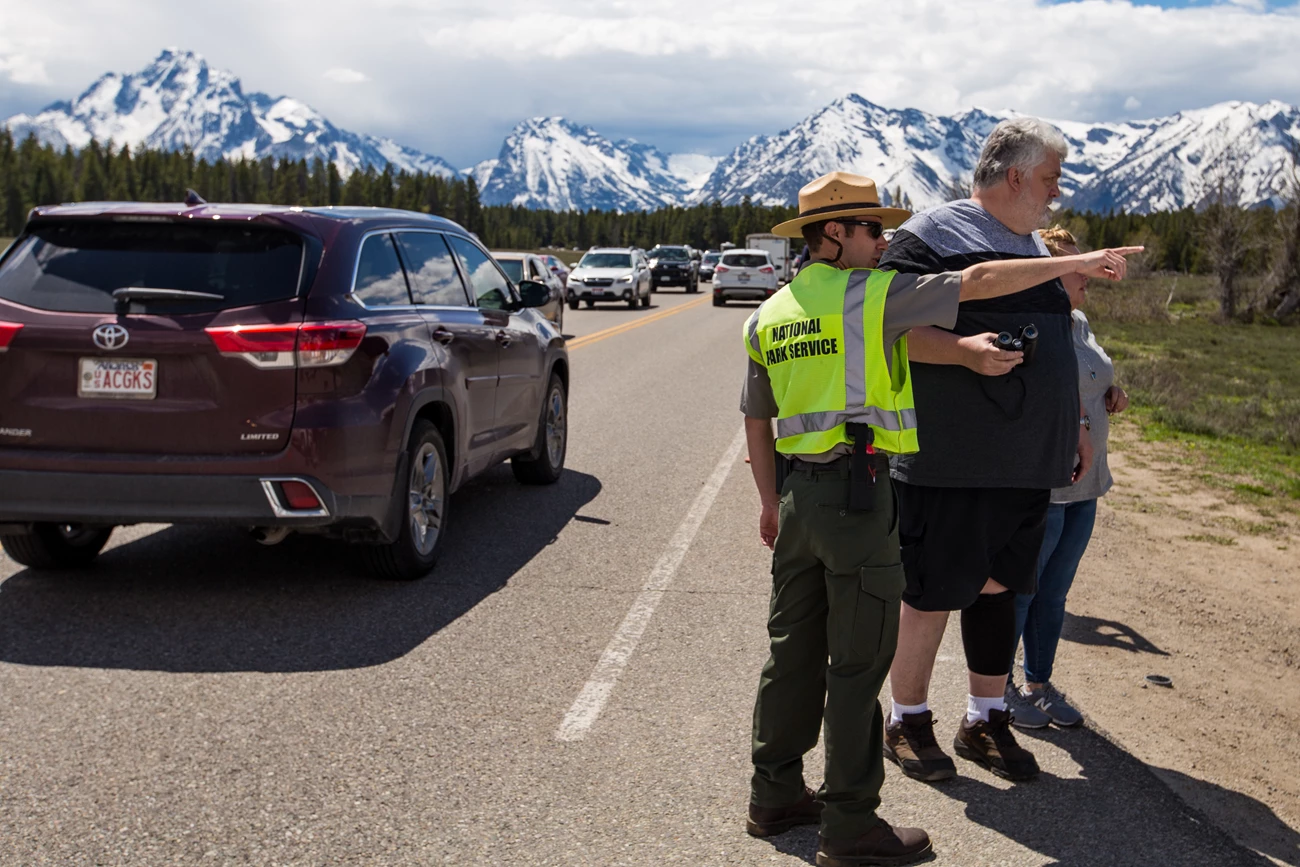
Credit: NPS / Adams
National parks have long been striking places to observe the human-wildlife interface. In the Greater Yellowstone Ecosystem (GYE), recovering grizzly bear populations have grown, and so have their interactions with people—especially along roads. Changes in both bear abundance and park visitation patterns have contributed to these increasingly common encounters. Today’s approach to managing human-wildlife interactions like “Bear Jams” reflects decades of park history and evolving science. Park biologists are continually working to minimize human impacts on wildlife while allowing for visitors to learn about and appreciate bears. History of the Human-Bear Interface
While grizzly bears have roamed the region we now call the Greater Yellowstone Ecosystem (GYE) for centuries, human activities associated with pioneer settlement haven’t always made it easy. By the early 1900s, grizzlies had been eliminated from most of their historic range in the western United States. One of these isolated populations persisted in the core of Yellowstone National Park. However, that’s where the story makes a dramatic transition. In the decades since Yellowstone’s grizzly bears were listed as threatened under the Endangered Species Act in 1975, an overwhelming conservation success story has followed. Thanks to the tremendous efforts of biologists, public land managers, local communities, private landowners, outdoor enthusiasts, and so many others, over 1,000 grizzly bears roam Greater Yellowstone today.
How has management shifted over time?The way people and bears live together in this area has changed dramatically over the past century and continues to evolve today. This timeline shows key events from across the Greater Yellowstone Ecosystem, including Yellowstone and Grand Teton National Parks. While some early changes started in Yellowstone, they provide important context for the conservation strategies used in Grand Teton today. Our current approach is rooted in decades of learning and updating how we care for both bears and people to keep everyone safe and wildlife wild. Feeding bears and observing them at garbage dumps was common across the GYE. These practices contributed to food conditioning, increasing the risk of human-bear conflicts. Yellowstone averaged 48 bear-related injuries annually.
Yellowstone National Park and surrounding communities began closing open-pit garbage dumps and established food storage regulations. The move was controversial to some, as many local bears had become dependent on human food sources. Populations initially declined.
The U.S. Fish and Wildlife Service listed the grizzly bear as a threatened species under the Endangered Species Act, initiating coordinated recovery efforts across the GYE.
Food-conditioned bears were considered absent from the GYE. Populations began to recover and were reliant on natural food sources again.
Grizzly bears started appearing in roadside meadows in Yellowstone. Unlike their food-conditioned predecessors, these bears were habituated—tolerant of human presence without seeking food. Roadside sightings become popular among visitors.
Park managers attempted to deter habituated bears using hazing and translocation, but these measures were not always effective and required significant staff capacity. Bears continued to return to roadside corridors where natural foods were abundant. Recognizing the importance of natural foods along roadway corridors to a recovering grizzly bear population and the challenges of taking action towards every habituated bear, wildlife managers in Yellowstone shifted their approach, tolerating habituated bears along roadway corridors and instead managed visitors observing bear. Park staff began emphasizing minimum viewing distances and other bear viewing mitigations.
Grizzly bears began recolonizing Grand Teton National Park and the John D. Rockefeller, Jr. Memorial Parkway. Grand Teton documented its first habituated grizzly bear frequenting meadows near park roadways.
Grand Teton established the “Wildlife Brigade,” a team of seasonal wildlife management rangers and volunteers to manage bear viewing opportunities, patrol for unsecured bear attractants, and educate visitors about bear safety.
Grizzly bears occupy all of Grand Teton.
Wildlife Management vs People Management
NPS/C.J. Adams The Wildlife Brigade (a seasonal team consisting of a bear biologist, wildlife management rangers, and volunteers) uses an adaptive management approach to respond to changing conditions and behaviors. Their work includes:
Managing this human-wildlife interface takes significant staff capacity. In 2024 alone, the Wildlife Brigade responded to 254 black bear jams and 224 grizzly bear jams and contributed 12,800 volunteer hours. Wildlife Viewing Etiquette
Like any wildlife encounter, roadside wildlife jams can be highly dynamic depending on the scene. They can shift quickly based on the animal’s behavior, location, and surrounding conditions. The Wildlife Brigade uses a core set of strategies to manage the scene and adjusts operations based on the specific situation.

Credit: NPS Managing the Human Side of the JamUnmanaged wildlife jams can quickly become chaotic. While it may come as a surprise, the greatest danger is often not the animal, but the traffic. Drivers who stop must comply with the following safety protocols:
Depending on the animal’s behavior, nearby curves, or visibility conditions, it may be unsafe to exit a vehicle at all. In these cases, the Wildlife Brigade and other park staff will assess the situation and provide guidance. Staff may ask visitors to remain in their vehicle or slowly drive through the area. There may be times when bear jams need to be shut down due to unsafe conditions or unreasonable disturbance to the animal. When this occurs, you can help by departing the scene and looking for wildlife in other areas of the park. 
NPS Photo Protecting Crossings and Habitat UseWhile most wildlife avoid lingering near busy roadways, animals need to be able to cross roads to move across the landscape. The Wildlife Brigade is trained to recognize these moments based on behavioral cues that determine whether an animal is committed to crossing or just lingering near the road.Staff create safe corridors by holding traffic and clearing space for the animal to cross. Providing secure passage reduces stress on the animal, prevents traffic collisions, and allows wildlife to continue moving naturally through their habitat. Why Distance MattersCertain visitor behaviors such as surrounding a bear on multiple sides, leaving the shoulder to approach, or crowding an animal can endanger both people and bears. That moment of crowding might not only result in a lost viewing opportunity but also compromise the long-term safety of that animal.The Wildlife Brigade’s goal is always to provide for a safe, educational, and respectful experience for all. Visitors come from around the world to see wild bears in the park. But these incredible experiences depend on a shared responsibility: to protect bear populations and ensure that wildlife can continue to thrive here, not just today—but for generations to come. Preventing Vehicle CollisionsAlong with bears, Grand Teton is home to a diverse array of wildlife, including moose, elk, bison, and wolves. Unfortunately, vehicle collisions can present a significant risk to these animals. Each year, 75-100 large animals are struck by vehicles on park roads, which often results in the death of the animal, substantial property damage and ocasionally human injury. 
NPS/M.Nall Why it Matters:
How to Reduce Collisions:
Legal Consequences:Accidents happen. Sometimes an animal suddenly runs into the travel lane, providing the driver no time to react to avoid a collision. While drivers are required to report all motor vehicle accidents, including wildlife strikes, a citation will not always be issued. Call Teton Interagency Dispatch Center at 307-739-3301 to report wildlife-vehicle collisions. By driving responsibly and staying alert, you help protect the park's wildlife and ensure a safer experience for all visitors and residents alike. Intervening with Intention, HazingWhile most bear management in Grand Teton focuses on influencing human behavior, there are times when direct intervention with bears is necessary. Developed areas pose a higher risk for human-bear conflict. Bears lingering on roadway shoulders or walking along asphalt are more vulnerable to vehicle strikes. In either of these cases, park staff may use hazing techniques to encourage the bear to move away.Frequently Asked Questions About Hazing Hazing is the use of unpleasant stimuli, such as loud noises, to temporarily modify a bear’s undesirable behavior, such as lingering in a campsite, walking on the road, or attempting to access human items.
Bear management programs around the world, including at Grand Teton, use hazing techniques to minimize the potential for human-bear conflicts around developed areas and along roadways. This provides for human safety and protects bears.
Grand Teton has a formal hazing policy that defines when hazing of bears is warranted, how hazing techniques are to be used, and what training is required of staff implementing hazing actions. A core principle of the park’s hazing policy is safety - safety of the animal, safety of visitors, and safety of staff.
Hazing is only used when it is deemed safe and appropriate to do so and when the bear has a clear path to go. Trained staff use behavioral cues from the bear to make decisions about how to implement hazing. For example, when arriving on scene, staff will assess which direction the bear is trying to go. Staff will clear a path in that direction and apply appropriate hazing pressure to keep it moving along its chosen trajectory. To define when hazing of bears is appropriate, Grand Teton’s hazing policy divides the park into four broad-scale zones based on location:
Developed areas: Areas such as campgrounds, lodges, and employee residential areas, are managed for people. While bears are tolerated transiting through developed areas as they move across the landscape, bears are not tolerated lingering in these areas. When bears are localized in and around human developments, there is an elevated risk to human safety and an increased chance of a human-bear conflict. Road corridors: Park roadways are busy thoroughfares managed for visitor traffic. While bears are tolerated crossing roadways as they freely move across the landscape, bears are not tolerated lingering on asphalt surfaces or adjacent road shoulders. Bears that linger on or next to roadways are more likely to be struck by vehicles or be involved in human-bear conflicts. When a bear approaches a roadway, trained park staff use behavioral cues from the animal to assess whether it is committed to crossing the road. During a crossing event, park staff will proactively stop and clear traffic to allow the bear to cross. However, if the bear lingers near the roadway and does not commit to crossing, then staff will implement hazing techniques to encourage the bear farther from the roadway for animal and human safety. Transition areas: Bears often forage along meadows, riparian areas, and other important habitats visible from park roadways. These transition areas provide seasonally important natural foods for bears and other wildlife. Bears are generally allowed to access these areas for natural behaviors, including foraging. When bears are visible, park staff respond to manage the resulting ‘bear jam’ - a traffic jam resulting from visitors stopping to watch the bear. During bear jams, visitors are required to maintain at least 100 yards from the bear at all times, including while in their vehicles, and follow direction from park staff. In certain areas, park staff use additional strategies to manage the human-bear interface, such as no stopping zones or temporary area closures. Hazing is generally only implemented if a bear approaches the roadway and lingers in the road corridor. Backcountry: In areas away from park roadways, bears are generally given priority where bear and human activities are not compatible. In the backcountry, park staff proactively implement seasonal area closures in known high-use bear areas or temporary trail closures when a prey carcass is nearby. Bears are not generally hazed in the backcountry, except in situations where a bear is lingering in a backcountry campsite or patrol cabin. When appropriate and safe to do so, trained park staff use a spectrum of hazing techniques ranging from ‘soft’ to ‘hard’. Staff always begin at the low end of the spectrum and only using more intensive tools when the bear is unresponsive to other techniques.
Soft hazing tools: At the lower end of the spectrum, soft hazing tools involve vehicle threat pressure, human threat pressure, lights, sirens, and horns. These unpleasant stimuli encourage the bear to keep moving and are the primary tools used by park staff. Hard hazing tools: At the upper end of the spectrum, hard hazing tools involve noisemakers or less-than-lethal contact rounds fired from a shotgun. These techniques are only implemented by specially-qualified staff and only when the bear is unresponsive to soft hazing tools. Hard hazing delivers a temporary painful stimulus to the bear without injuring the animal.
Bear spray is an effective deterrent only to be used when a bear is running towards a person at close range and is likely to make contact with the person. Bear spray is not a hazing tool.
Grand Teton recommends that visitors recreating in the park carry bear spray and know how to use it. However, bear spray is only to be used as a last line of defense. As important as carrying bear spray, visitors should be alert, make noise, and hike in groups while recreating in the park. Expect to see bears along park trails, and never run if you see a bear. While bears with dependent young are not allowed to linger in developed areas or along roadways, there are special considerations to moving a family group. Hazing is generally minimized unless absolutely necessary. Extreme care is taken to avoid animal injury or separation of cubs.
In most cases, only soft hazing tools are used, and hazing is conducted as gently as possible while still encouraging the bears away. However, when a family group repeatedly lingers in a developed area and is unresponsive to soft hazing techniques, specially-qualified wildlife biologists may strategically implement hard hazing techniques when safe to do so and within strict guidelines. All staff at Grand Teton receive basic training on how to work safely and responsibly in bear habitat. This includes instruction on how to use bear spray and practice on a charging bear simulator.
For staff who manage bear jams or conduct hazing, additional training is required. Elements include:
For the direct handling of animals, wildlife biologists at the park complete intensive training to become certified wildlife immobilizers able to safely capture bears and other wildlife in accordance with strict protocols and veterinary oversight. Developed areas are bustling places, often with a dense collection of campsites, restaurants, stores, residences, and other establishments. Human foods are often left unattended. Roadways are filled with moving cars. Kids are riding their bicycles. Visitors abound.
Many people have a false assumption that bears are only in the backcountry and may not be prepared to encounter a bear next to the visitor center parking lot. This concentration of human activity presents high risks to bears who linger. A bear is more likely to come across an unattended food item or be struck by a passing vehicle. A bear may feel crowded and suddenly act aggressively. A visitor might panic and run, provoking a bear to charge and react defensively. Grand Teton manages developed areas for people. Bears are free to pass through, but they cannot linger for their safety and ours. The risk of a human-bear conflict is just too great, and the bear often pays the price when a conflict occurs. Most of Grand Teton is undeveloped and provides excellent habitat for bears to roam unimpeded and meet their life history needs- and without all the risks presented by concentrated human activities. Female bears with cubs have to navigate a landscape of competing factors. They need to find sufficient natural foods to feed themselves and their young, but only certain foods are available at any given time. They have to avoid male bears who may present a threat to their cubs, but the population is larger today than it was a decade ago. They must maneuver around humans, roads, and developments, but visitor use patterns continue to change. The availability of natural foods also changes over the course of the season. Immediately after emerging from their winter dens, bears tend to move into lower elevations where the snow has melted and the first natural foods are abundant. As the temperatures warm, many bears move into other areas following their food sources. Preventing Food Conditioning
Credit: NPS Most human-bear conflicts occur when human food is left unsecured. A curious bear may take advantage of this mistake, which often leads to the bear repeating the behavior and park staff having to intervene. Preventing food conditioning is critical. Bears have an extraordinary sense of smell. They can detect odors from great distances and use their powerful memory to recall where they’ve found food before, even years later. If human food is easy to access, a bear may return to the area, associating people and developed spaces with easy food sources. To ensure this doesn't happen, any item with an odor—whether food, trash, toiletries, or pet food—must be properly stored. When not in use, attractants should be secured in a hard-sided structure, inside a vehicle with the windows rolled up, or a bear-resistant storage locker. Even something as simple as an abandoned backpack or trash left in a firepit can present a food reward and alter a bear’s future. Examples of Attractants
Monitoring SuccessPark staff monitor the human-wildlife interface by documenting bear sightings, traffic jams caused by wildlife, conflicts between people and bears, and wildlife-vehicle collisions. This information helps evaluate how well current strategies are working and when changes are needed. 
Credit: NPS Tracking How Bears Move Through the LandscapeUsing GPS radio collars, park biologists study how grizzly bears travel and when they’re active. These collars provide insights into:
This method of telemetry was pioneered by Frank and John Craighead in the 1960s–70s, laying the groundwork for modern bear research. The Interagency Grizzly Bear Study Team aims to maintain at least 25 collars on reproducing females and a sample of males across the Greater Yellowstone Ecosystem.
|
Last updated: July 18, 2025


